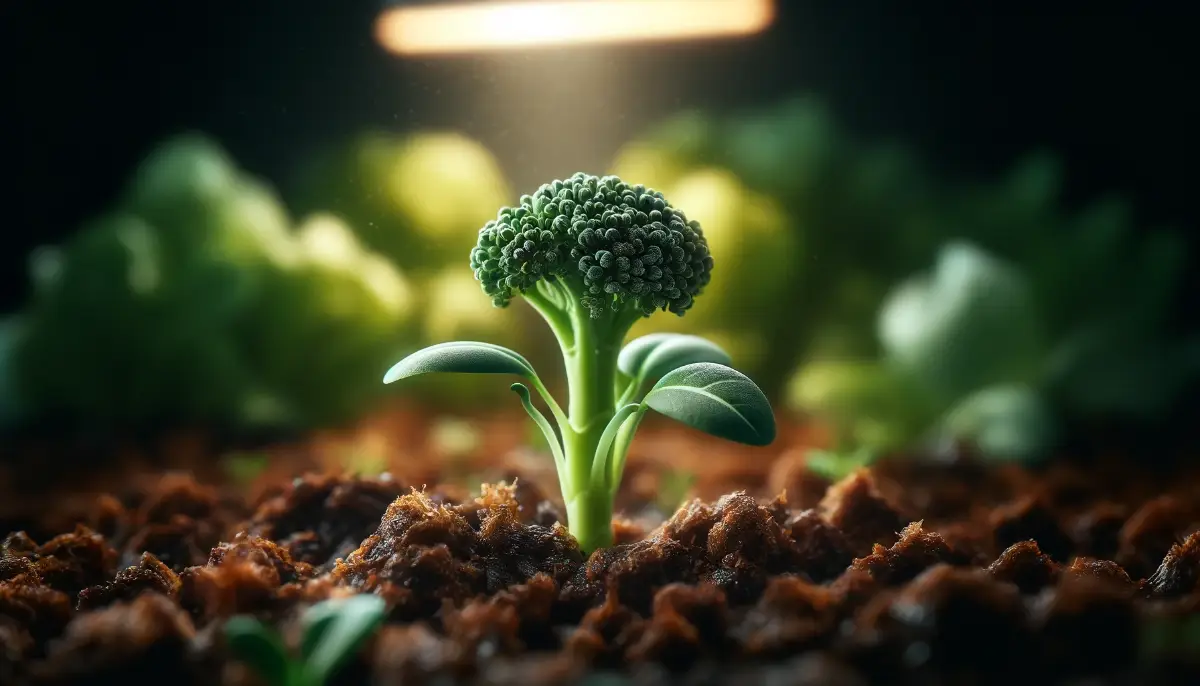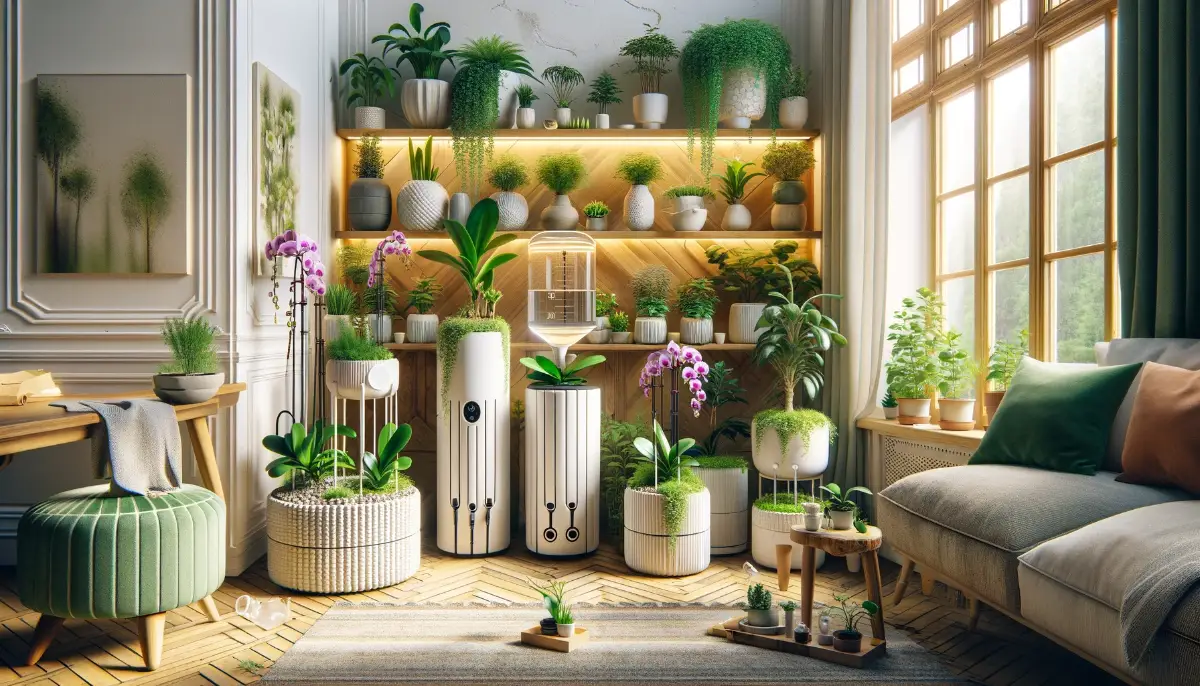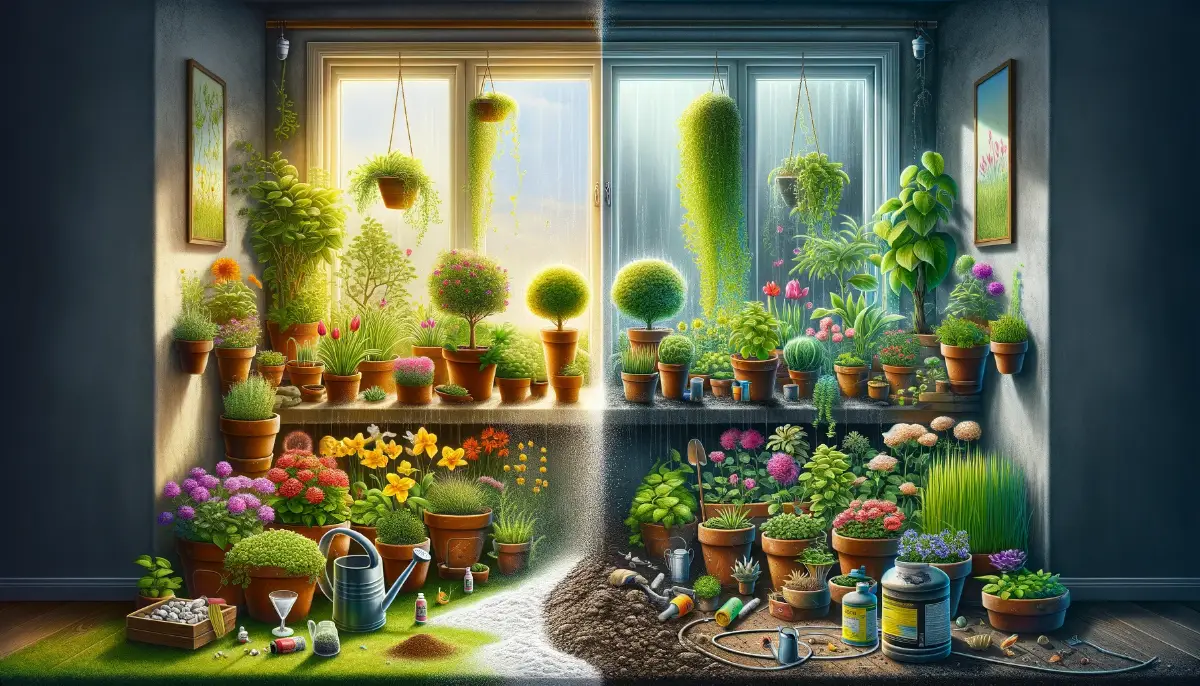This article will guide you through the process of growing broccoli organically indoors, from selecting the right container to harvesting your homegrown veggies. We’ll cover the key aspects that will help ensure your indoor broccoli garden thrives, so you can enjoy fresh, organic produce right from your home.
How to Grow Organic Broccoli Indoor
Growing broccoli indoors isn’t just about adding a green touch to your indoor space; it’s about embracing a healthier, more sustainable lifestyle. Broccoli, known for its nutritional benefits, thrives in indoor environments with the right care, making it a perfect candidate for your indoor garden.
Not only does it provide a continuous supply of fresh produce, but it also introduces an engaging hobby that benefits both your home and health.
- Choosing the right container ensures adequate space for broccoli’s growth.
- Adequate light is crucial; 6-8 hours daily or supplemented with grow lights.
- Proper watering and feeding practices keep the soil at the ideal moisture level.
- Maintaining the right temperature prevents bolting and encourages steady growth.
Choosing the Right Container and Soil
Container Size: Start with a 3 to 5-gallon pot for each broccoli plant, ensuring enough space for its growth. Broccoli’s root system spreads out, so a wider pot is preferable to a deeper one. The pot must have adequate drainage holes to prevent waterlogging.
Soil Type: Use a high-quality potting mix, ideally one that’s designed for vegetable growing. Mixing in compost can improve the soil’s fertility and water retention. Avoid using garden soil as it may not drain well and could contain pests or diseases.
Ensuring Adequate Light
Light Requirements: Broccoli needs about 6-8 hours of light daily. If you’re lacking in natural sunlight, supplement with LED grow lights. Position the lights 12-18 inches above the plants, and maintain a photoperiod of 12-16 hours per day to simulate natural light conditions effectively.
Maintaining Optimal Temperature and Humidity
Temperature: Keep your indoor garden within the optimal temperature range of 60-70°F during the day and 50-60°F at night. Broccoli thrives in cooler temperatures, and excessive heat can cause the plant to bolt or produce poor quality florets.
Humidity: Aim for a humidity level between 50 to 70%. This balance supports healthy growth without encouraging mold or fungal diseases. Use humidifiers or dehumidifiers as necessary to maintain these levels.
Watering and Feeding
Watering: The soil should be kept moist but not soggy. Check the top inch of soil for dryness and water accordingly. Overwatering can lead to root rot, while underwatering can stress the plant, affecting its growth and yield.
Fertilizing: Broccoli is a heavy feeder but requires careful fertilization to avoid nutrient burn. Use a balanced, half-strength vegetable organic fertilizer every other month. If you’ve enriched your soil with compost, you may need to fertilize less frequently.
By following these steps carefully, you can create an ideal growing environment for your broccoli plants indoors. The success of your indoor broccoli garden depends on balancing these elements to mimic the outdoor conditions broccoli would naturally thrive in. With patience and care, you’ll be rewarded with a bountiful harvest of fresh, homegrown broccoli.
Organic Pest and Disease Management
Common Pests: Broccoli can attract several pests such as aphids, cabbage loopers, and cutworms. To manage these organically:
- Aphids: A strong spray of water can dislodge aphids from plants. For severe infestations, use an organic insecticidal soap.
- Cabbage Loopers: Handpicking and using Neem oil are effective methods.
- Cutworms: Protect seedlings with cardboard collars placed around the stem at soil level.
Disease Prevention: Fungal diseases like downy mildew and clubroot can be prevented through good cultural practices. Ensure adequate airflow, avoid overhead watering, and use a mulch layer to keep soil-borne pathogens from splashing onto leaves. For soil-borne diseases like clubroot, maintaining a well-balanced pH in your potting mix can prevent outbreaks.
Harvesting Broccoli
When to Harvest: Broccoli is ready to harvest when the heads are firm and tight before the flowers start to bloom. This usually occurs a few months after planting, depending on the variety and growing conditions. Harvesting in the morning can result in a crisper, more flavorful broccoli.
How to Harvest: Use a sharp knife to cut the head of the broccoli, leaving at least 6 inches of the stem on the plant. This encourages the plant to produce side shoots, which can also be harvested later on. Be sure to harvest any side shoots while they are small to ensure the best flavor.
Post-Harvest Care: After harvesting, broccoli can be eaten fresh, stored in the refrigerator for up to a week, or blanched and frozen for longer storage. To maximize freshness, store broccoli in a perforated plastic bag in the vegetable crisper drawer.
Tips for Ongoing Care
- Soil Health: Continue to maintain soil health by adding organic compost or a balanced organic fertilizer as needed. Healthy soil promotes strong plant growth and reduces susceptibility to pests and diseases.
- Watering: Consistent moisture is key. Water deeply and evenly to keep the soil moist but not waterlogged, focusing on the root zone to minimize leaf wetness and reduce disease risk.
- Monitoring: Regularly check your plants for signs of pests or disease. Early detection is crucial for organic management strategies to be effective.
By following these organic care and harvesting tips, you can enjoy a successful indoor broccoli harvest while adhering to sustainable gardening practices. Remember, patience and observation are key to any gardening success.
FAQs on Indoor Broccoli Growing
How long does it take to grow broccoli indoors?
Broccoli grown from seed can take anywhere from 100 to 150 days to reach harvest when grown indoors. If you start with transplants, the time frame can be reduced to 55 to 80 days. The exact time to harvest can vary based on the variety and growing conditions.
Can I grow broccoli indoors in any type of container?
While broccoli can be grown in various containers, it’s crucial to choose one that is large enough to accommodate the plant’s root system and has adequate drainage. A 3-5 gallon pot is generally recommended for each broccoli plant.
How much light do indoor broccoli plants need?
Broccoli plants require at least 6-8 hours of direct sunlight per day. If natural sunlight is insufficient, supplementing with grow lights can provide the necessary light exposure to ensure healthy growth.
What is the best soil for growing broccoli indoors?
Broccoli thrives in slightly acidic to neutral soil (pH 6.0-7.0), which is well-draining and rich in organic matter. Mixing high-quality potting soil with compost can create an ideal growing environment for indoor broccoli plants.
How often should I water my indoor broccoli plants?
Water your broccoli plants to keep the soil consistently moist but not waterlogged. The frequency will depend on the humidity and temperature of your indoor environment, but a general guideline is to water when the top inch of soil feels dry to the touch.
Do I need to fertilize my indoor broccoli plants?
Yes, fertilizing is important for the growth and health of broccoli plants. Use a balanced, organic fertilizer every other month, or follow the instructions provided with your specific fertilizer. Be cautious not to over-fertilize, as this can harm the plants.
How do I prevent pests on my indoor broccoli plants?
Keep an eye out for common pests like aphids and spider mites. Using organic pest control methods, such as neem oil or insecticidal soap, can help manage these issues without resorting to harsh chemicals.
When is the best time to harvest broccoli?
Harvest broccoli when the head is fully formed but before the flowers start to bloom. The heads should be firm and tight. Use a sharp knife to cut the stem about 5-6 inches below the head.
Can broccoli be regrown after harvesting?
Yes, after harvesting the main head, broccoli plants can produce additional side shoots that can also be harvested. Continue to water and care for the plant to encourage these shoots to develop.
What are some common challenges in growing broccoli indoors?
Some common challenges include providing enough light, maintaining the right temperature, and managing pests and diseases. Using grow lights, monitoring indoor temperatures, and employing organic pest control methods can help address these issues.









